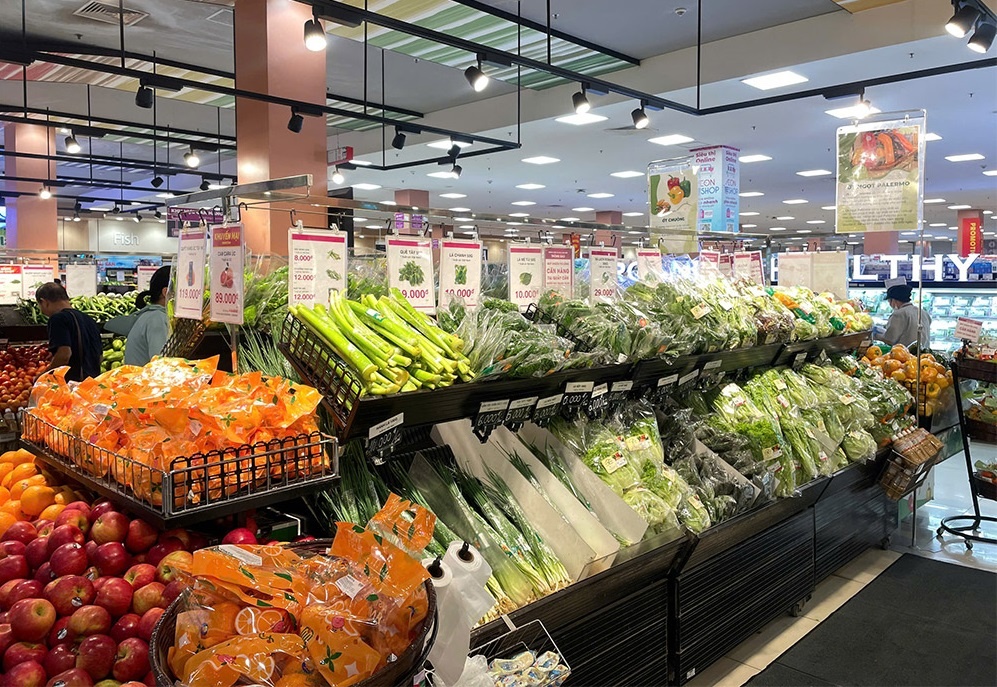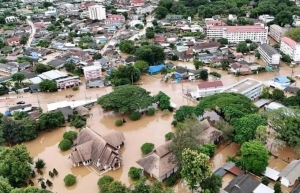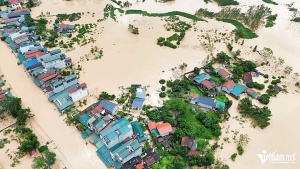Food supply ensured in wake of typhoon
Just a few hours after Hanoi People’s Committee issued a directive warning of widespread flooding on September 10, the temporary scarcity of fresh food and vegetables began to spread in many supermarkets in the capital.
Kim Tuoi in Tay Ho district stated that the fresh food counters at three WinMart+ and Fujimart supermarkets on Lac Long Quan and Thuy Khue streets were all empty on the evening of September 10.
 |
| Food supply ensured in wake of typhoon, illustration photo |
“We have nothing left to buy,” Tuoi said. “The vegetable and fresh food counters were all closed, supermarket staff said everything had been bought up since that afternoon. Some dry items like instant noodles, bread, and canned food were also running low,” she added. However, the scarcity situation quickly ended the next day, as supermarkets continuously restocked shelves.
Central Retail Vietnam’s supermarket system has a plan to ensure a stable supply of goods to meet the needs of people in areas affected by the typhoon, and maintain prices. For fruit and vegetables, its GO! and Big C supermarkets have doubled the usual quantity. On average, each truck from the Central Highlands city of Dalat to central and northern regions will carry up to 80 tonnes of fruit and veg, around double the usual tonnage per trip.
According to communications director Nguyen Thi Bich Van, while some farming areas and meat and seafood processing plants in typhoon-affected areas were still experiencing water and power outages, Central Retail suppliers were still working to overcome the issues and increase production to make up for it.
“The supply is still ensuring about 90 per cent of customer demand. We are also increasing imports of frozen goods as a way to supplement additional sources of goods, ensuring to meet the high demand of customers,” Van said.
Olivier Langlet, CEO of Central Retail Vietnam, said that in areas where GO! and Big C supermarkets are operating, the company will deploy staff to coordinate with local authorities to deliver relief supplies.
“We hope that these essential supplies will contribute a small part in helping our fellow citizens in the typhoon-affected areas overcome difficulties quickly, step by step stabilising their lives,” Olivier said.
Meanwhile, the largest domestic retail chain in Vietnam, WinMart and WinMart+, acknowledged that consumers have high demand for fresh foods such as fruit and vegetables, meat, fish, beverages, and other essential consumer goods.
Since last week, the WinMart supermarkets and smaller stores have added nearly 100 tonnes of fruit and vegetables daily from WinEco farms in the Central Highlands province of Lam Dong and southern provinces to supermarkets in Hanoi and other areas.
“We have planned to coordinate goods from southern regions to the north in the case of a supply shortage. Consumers can shop with peace of mind, and they should not stockpile too much to avoid local shortages during peak hours,” a representative of WinMart added. “Prices are stable and have not increased compared to before the typhoon.”
According to an update from the Domestic Markets Department under the Ministry of Industry and Trade, the distribution and retail systems are still serving the needs of the people. Except for some types of green vegetables that have slightly increased in price due to difficulties in preservation, shortages and price increases of essential consumer products are not taking place in areas affected by Yagi.
“The ministry continues to direct the department, distribution businesses, and suppliers to update the situation of goods in affected provinces and cities to provide timely support when needed,” said Bui Nguyen Anh Tuan, deputy director of the Domestic Market Department.
Based on the experience of Japanese retailer AEON Vietnam, diversifying suppliers and establishing long-term partnerships with reputable large suppliers are ways for retailers to build up backup sources in critical situations.
More than a week before Typhoon Yagi made landfall, AEON Vietnam supermarkets and general merchandise stores had prepared a plan for their source of goods. AEON worked with partners to ensure supply, focusing on essential daily products such as rice, instant noodles, fruit and vegetables, meat, fish, frozen foods, and beverages. At distribution centres, AEON also increased storage capacity.
“The aftermath of the typhoon may have an impact on suppliers, especially those supplying fresh goods. However, these are only short-term difficulties. AEON Vietnam is still working closely with partners to ensure a stable supply of goods at reasonable prices without interruption,” an AEON representative stressed.
| Foreign organisations have provided immediate aid to support Vietnam’s efforts to respond to the devastating impacts of Typhoon Yagi. The US Mission to Vietnam, through the US Agency for International Development, is providing $1 million in humanitarian aid to support Vietnam in the aftermath of the typhoon. The assistance will be allocated to humanitarian partners to provide multipurpose cash assistance, shelter, water, sanitation, and hygiene assistance, as well as non-food items. This $1 million builds upon long-standing support to the government and the Vietnam Red Cross Society to strengthen resilience to climate change and the disaster response capabilities of communities across the country. Over the past five years, the US Mission to Vietnam has provided $7.7 million in emergency response and disaster preparedness assistance - including to address needs generated by floods and typhoons and build the capacity of local first responders across Vietnam. Besides that, the Australian government will provide Vietnam with an initial $2 million for humanitarian relief, emergency supplies, and other essential services in response to Yagi. Australia’s Ambassador to Vietnam Andrew Goledzinowski said, “Australia is here to help Vietnam in any way we can. We are pleased we’ve been able to quickly mobilise support to the most impacted areas and are working closely with the government of Vietnam and to ensure support reaches affected families and communities. We know there’s a long road ahead, and we stand shoulder to shoulder with Vietnam at this difficult time.” Australia’s assistance will include services delivered through the Australian Humanitarian Partnership in concert with local organisations targeting the most affected communities and the most vulnerable populations. The contribution will ensure women, children, and those with disabilities can access lifesaving assistance. These supplies include essential provisions for families, such as shelter and hygiene kits. Japan and South Korea are also providing aid to support countries suffering the consequences of the storms. South Korea has donated $2 million to help Vietnam recover from storm damage, while the Japan International Cooperation Agency announced the provision of emergency relief supplies, including water purification equipment and multifunctional plastic sheets. |
 | Typhoon Yagi claims 74 lives in Myanmar, causes flooding in Thailand, Laos The Global New Light of Myanmar reported on September 15 that as of September 13 evening, flooding and landslides triggered Typhoon Yagi in the country had left 74 and 89 others missing. |
 | Typhoon Yagi estimated to cause $1.6 billion in damage for Vietnam An estimated $1.6 billion in damages has been incurred due to Typhoon Yagi, with a projected 0.15 per cent reduction in Vietnam’s GDP for 2024. |
What the stars mean:
★ Poor ★ ★ Promising ★★★ Good ★★★★ Very good ★★★★★ Exceptional
Related Contents
Latest News
More News
- Protect what’s next: towards a future free from meningococcal group B disease (December 05, 2025 | 18:00)
- New ILO report offers policy recommendations for disability inclusion (December 04, 2025 | 15:18)
- Maternal job loss may affect children’s mental health, research shows (December 03, 2025 | 19:11)
- Women lead Vietnam’s shift to climate-resilient agriculture (December 03, 2025 | 19:10)
- Experts highlight unpaid care work as key barrier to gender equality (December 03, 2025 | 15:15)
- Opportunities and inequalities for women workers in Vietnam's garment industry (December 03, 2025 | 09:00)
- Vietjet flights carry love to devastated central region (November 28, 2025 | 11:35)
- New initiative to boost the fight against domestic violence (November 26, 2025 | 10:00)
- South Korea funds IOM relief for Vietnam’s typhoon-affected communities (November 24, 2025 | 15:33)
- AI and human-centred values set to shape the future of HR in Vietnam (November 21, 2025 | 18:04)

 Tag:
Tag:




















 Mobile Version
Mobile Version